|
Navy LCVP Contract Page
Landing Craft Construction
Photo Page
Chris-Craft in World War Two
Algonac, MI (Closed in 1970)
1910-Present (Currently owned by Winnebago)
An American Auto
Industry in World War Two Special Edition
Michigan was the location of the
country's largest small boat industry at the beginning of World War Two.
It produced boats for the war effort ranging in size from small rafts to destroyer escorts. Chris-Craft was the largest small boat
manufacturer in the country. During World War, Two Chris-Craft
received Navy contracts for at least 12,935 landing craft that were instrumental in landing American troops
onto hostile beaches.
This page updated 9-6-2020.
Even for a non-boating person like myself, the name Chris-Craft brings to
mind images of highly polished mahogany boats. Before and right
after World War Two, Chris-Craft was
synonymous with fine wooden boats. It was the largest wooden boat
builder in the world at the time. Chris-Craft's headquarters and
main plant were located in Algonac, MI
along the St. Clair River in southeastern Michigan. This was only
50 miles from downtown Detroit and the center of the automobile industry.
Their location provided a close customer base for many of its products. In
1939 Chris-Craft expanded into Holland, MI, on the western side of the
state, along
Lake Michigan. In January 1941, another plant was added in
Cadillac, MI. It is on Lake Cadillac but has no water-way access
to any of the Great Lakes. All of the boats produced in Cadillac
had to be trucked to
their destinations.
In March 2020 I visited the Algonac-Clay
Township Historical Society in Algonac, MI to research Chris-Craft. The Historical Society has two museums in downtown
Algonac, just one mile north of the original Chris-Craft plant and
headquarters. Both museums are well worth the visit for those
interested in Chris-Craft, Michigan maritime history, or the local
history of the area. My trip to the museums was most fruitful to
my research.
 a a
This 1949 Chris-Craft Model B is on display
at the Algonac Maritime Museum. It is of the classic wooden
construction before the introduction of fiberglass boats. The
museum displays an excellent collection of Chris-Craft memorabilia and photos.
Several of the photos and artifacts are from the World War Two era, when
the company built 12,395 landing craft for the war effort.
Author's photo added 3-15-2020.

Author's photo added 3-15-2020.

Author's photo added 3-15-2020.

The museum has one room dedicated to the
former Chris-Craft company in Algonac. Author's photo added
3-15-2020.

Author's photo added 3-15-2020.

This bronze plaque is on display at the
Algonac Community Museum. Author's photo added 3-15-2020.
The Army-Navy "E" Award:

On June 15, 1942, all three Chris-Craft
plants were awarded the Navy "E" Award.

Author's photo added 3-15-2020.
In July 1942, the Army and Navy combined
their respective "E" awards into the Army-Navy "E" award.
Companies that had already won the Navy "E" award had the option
of continuing the war with Navy flags or converting to the combined
award and flag. Chris-Craft chose to convert. The actual Army-Navy
"E" flag from the Cadillac, MI plant is shown below. It has two
stars on it because the Cadillac, MI plant won two more awards.

Tom Robbins, son of Maureen Robbins, was helping his mother clean out
her garage in late May-early June 2018 when the flag was found.
Mrs. Robbin's father was the plant manager of
the Holland Plant from 1942 until 1968. It is assumed the flag will stay in the
family. What a garage find!!! The flag appears to be in
great shape after spending many years in garage storage.
The Chris-Craft Algonac, MI plant won the
award three more times.
The Chris-Craft Holland, MI plant won the award four more times.

The workers at the Algonac plant are bundled
up for the cold on
November 4, 1943 for an "E" award ceremony. Photo
courtesy of the Algonac-Clay Township Historical Society added 3-15-2020.
Chris-Craft World War Two Production
Statistics: Chris-Craft built at least 13,283 small boats of
eleven different types for the U.S. Navy and U.S. Army. It was the
second largest producer of small boats during the war.

Chris-Craft built eleven different types of
small craft during World War Two, including the 33-foot long Radio
Controlled boat and the 36-foot Navy Picket boat, which were built in the
Algonac, MI plant. Several of its products were provided to the U.S.
Army, which had its own navy during the war. This may sound counter-intuitive,
but the Army had bases along the coasts of the Mediterranean and on many
islands of the Pacific. The Army needed watercraft for air-sea
rescue and water transportation at these
bases.
|
Table 1 -
Total Chris-Craft Built During World War Two |
|
Boat Type |
Number Built |
| U.S. Navy |
105 |
| U.S. Army |
243 |
| Landing Craft |
12,935 |
| Total |
13,283 |
Chris-Craft's signature product during World War
Two was the 36-foot wooden landing craft. There were four different
types and Chris-Craft was the only company that built all four.
These were the Landing Craft, Personal, (Large), (LCP(L)); the Landing
Craft, Personal, (Ramp), (LCP(R)); the Landing Craft, Vehicle, (LCV);
and the Landing Craft, Vehicle, Personnel, (LCVP). They were built in all three
plants, although the Holland and Cadillac plants were the main high
volume producers. During World War Two Chris-Craft built at least
42% of all the 36-foot landing craft.
|
Table 2 - Chris-Craft 36-foot
Landing Craft Built by Type |
|
Type |
Number Built |
Chris-Craft Percentage of Total
Built |
|
LCP(L) |
1,038 |
46% |
|
LCP(R) |
2,432 |
92% |
|
LCV |
600 |
27% |
|
LCVP |
8,865 |
38% |
|
Total |
12,935 |
42% |
Notes on Table 2:
As Table 3 shows, the number of LCP(L)s is a minimum, as the
number of LCP(L)s in Chris-Craft Contract number 8 is unknown.
Chris-Craft Contract number 13 is of an unknown type and
quantity. Therefore, the 12,935 is a minimum number of landing
craft that Chris-Craft built during World War Two.
Table 3 - Chris Craft Landing Contract Information
The information below
comes from the Maritime Museum, Newport News, VA Chris-Craft
corporate records unless noted otherwise. Note that the
information is not uniform, and much of it is incomplete. |
|
Landing Craft Type |
Navy Contract Number |
Chris-Craft Contract Number |
Number of Landing Craft Built |
Navy Hull Numbers |
Chris-Craft Serial Numbers |
Other Information |
| LCP(L) |
NObs
97556 |
1 |
38 |
C-4816 to C-4853 Inclusive Inc. |
LB-1 to LB-37 Inc.
|
Shipment was between
4-13-1942 and 6-4-1942. The engines were Gray 64HN4. |
| LCP(R) |
NObs
97556 |
1 |
162 |
C-4854 to C-4986 Inc., C-7560 to C-7588 Inc. |
LB-38 to LB-200 Inc. |
Shipment was between 4-13-1942 and 6-4-1942. The engines
were Gray 64HN4. |
| LCP(R) |
NObs
97556 |
2 |
725 |
C-8460 to C-8584 Inc., C-10155 to
C-10174 Inc. |
LB-201 to LB-925 Inc. |
Shipment was between 6-3-1942 and
10-3-1942. The engines were:
175 Buda DD Type 104 hp
13 Gray Four Cylinder GMD45 110 hp
13 Gray Four Cylinder GMD46 110 hp
94 Gray 64HN4 225 hp
430 Chrysler Eight Cylinder Type R-8 140 hp |
| LCV |
NObs
97556 |
2 |
400 |
C-11555 to C-11954 Inc. |
VR-1
to VR-400 Inc. |
Shipment was between 7-1-1942 and 9-23-1942. The engines
were:
360 Gray 64HN4 225 hp
20 Gray 64 165 hp
20 Gray 69S 165 hp |
|
LCV |
NObs 97556 |
3 |
200 |
C-11355 to C-11554 Inc. |
VR-401 to VR-600 Inc. |
Shipment was between 9-14-1942 and
2-1-1943. The engines were:
200 Gray 64HN4 225 hp |
| LCP(R) |
NXs
718 |
4 |
600 |
C-9505 to C-10104 Inc. |
LB-926
to LB-1525 Inc. |
Shipment was between 9-4-1942 and 1-16-1943. The engines
were:
523 Gray 64HN4 225 hp
77 Chrysler Royal Eight Cylinder Type R-8 140 hp |
| LCVP |
NObs
827 |
5 |
1,700 |
C-20071 to C-20670 Inc., C-22161 to C-23260 Inc. |
4001
to 5700 Inc. |
Shipment was between 1-23-1943 and 8-23-1943. The engines
were:
987 Gray 64HN9 225 hp
585 Gray 64HN6 225 hp
127 Gray 64HN4 225 hp
1 Gray 64HN6 225 hp (Reclaimed engine) |
| LCVP |
NObs
997 |
6 |
2,000 |
C-32782 to C-34781 |
|
Information from the Algonac-Clay
Township Historical Society. |
| LCVP |
NObs
1249 |
7 |
2,500 |
|
|
|
| LCP(L) |
NObs
1250 |
8 |
? |
|
|
|
| LCP(R) |
NObs
1433 |
9 |
300 |
|
|
|
| LCP(R) |
NObs
1730 |
10 |
225 |
|
|
|
| LCPL |
NObs
1731 |
11 |
550 |
|
|
|
| LCP(R) |
NObs
1881 |
12 |
150 |
|
|
|
| ? |
NObs
? |
13 |
? |
|
|
|
| LCVP |
NObs
1951 |
14 |
750 |
C-78769 to C-79518 Inc. |
|
|
| LCPL |
NObs
1972 |
15 |
225 |
C-87239 to C-87463 Inc |
|
Date
of contract Jan 29, 1945 Shipped by June 16 1945 |
| LCP(R) |
NObs
1988 |
16 |
270 |
C-87989 to C-88258 Inc. |
|
|
| LCVP |
NObs
2001 |
17 |
665 |
C-80299 to C-80953 Inc. |
|
|
| LCPL |
NObs
2023 |
18 |
225 |
C-87464 to C-87688 Inc. |
|
|
| LCVP |
NObs
2032 |
19 |
1,250 |
|
|
|
| |
|
Total |
12,935 |
|
|
|
Table 4 -
Chris-Craft Navy Boats
The information below
comes from the Maritime Museum, Newport News, VA Chris-Craft
corporate records. |
|
Boat Type |
Navy Contract Number |
Number
Built |
Navy Hull Numbers |
Chris-Craft Serial Numbers |
Other Information |
|
36-1/2-Foot Navy Harbor Picket Boat, Twin Screw |
NOs
96371 |
80 |
C-6046 to C-6075Inclusive (Inc.), C-6421 to C-6475 Inc. |
NP-1
to NP-80 Inc. |
Shipment was between 4-4-1942 and
5-27-1942. The engines were Chris-Craft Marine 150 hp.
80 Type WR RH Drive and 80 Type WRO LH Drive. |
|
36-1/2-Foot Navy Harbor Picket Boat, Twin Screw |
NXs
2196 |
25 |
C-7732 to C-7756 Inclusive Inc. |
NP-81
to NP-105 Inc. |
Shipment was between 7-18-1942 and
7-20-1942. The engines were Chris-Craft Marine 150 hp.
25 Type WR RH Drive and 25 Type WRO LH Drive. |
| |
Total
|
105 |
|
|
|
|
Table 5 -
Boats built by
the Chris-Craft Algonac,
MI Plant during World War Two
Note that the 243 boats described below are all for the U.S.
Army. Orders for the U.S. Navy Pickett boats shown in the
"Chris-Craft boats built for Victory," and the two magazine ads
shown below are not included. Navy small boat
purchase records from World War Two on are incomplete. Also note there
were no Army contracts after 1943. Algonac was a busy
place during the war, testing and making necessary repairs to
the 12,000 landing craft built in Holland and Cadillac, MI. |
| Designation
|
Number Built |
Customer |
Length (Feet) |
Description |
Year |
|
J 101-127 |
27 |
U.S. Army |
22 |
Shallow Draft |
1940 |
| J
144-145 |
2 |
U.S.
Army |
30 |
Shallow Draft |
1941 |
| J
168-196 |
29 |
U.S.
Army |
22 |
Air-Sea Rescue |
1941 |
| J 214 |
1 |
U.S.
Army |
34 |
Launch |
1941 |
| J
631-661 |
31 |
U.S.
Army |
22 |
Air-Sea Rescue |
1943 |
| J
690- 726 |
37 |
U.S.
Army |
43 |
Patrol |
1943 |
| |
|
|
|
|
|
| Q
2023 |
4 |
U.S.
Army |
60 |
Launch |
1941 |
| Q
36-39 |
4 |
U.S.
Army |
60 |
Launch |
1941 |
| Q 40 |
1 |
U.S.
Army |
55 |
Launch |
1941 |
| Q
54-66 |
13 |
U.S.
Army |
62 |
Passenger |
1942 |
| Q
69-77 |
19 |
U.S.
Army |
62 |
Passenger |
1942 |
| Q
88-102 |
15 |
U.S.
Army |
62 |
Passenger |
1943 |
| |
|
|
|
|
|
| V 16 |
1 |
U.S.
Army |
25 |
Motor
Boat |
1941 |
| |
|
|
|
|
|
| P
122-140 |
19 |
U.S.
Army |
42 |
Rescue |
1942 |
| P
151-180 |
30 |
U.S.
Army |
42 |
Rescue |
1943 |
| |
|
|
|
|
|
| AC
1-10 |
10 |
U.S.
Army |
43 |
Patrol |
1943 |
| |
|
|
|
|
|
|
Total |
243 |
|
|
|
|

Chris-Craft was the second largest
manufacturer of landing craft during World War Two. The newly built
Holland plant was the high volume plant for these types of boats for the
company. The Holland City News reported on September 28, 1944 that the Holland
Plant had produced its 8,000th landing craft, a Landing Craft, Vehicle,
Personnel (LCVP). This craft was also known more commonly as the Higgins Boat, after
its inventor Andrew Higgins of New Orleans.

Five months later, in February
1945, Chris-Craft produced its 10,000th landing craft, indicating a
production rate of 400 per month. The 10,000th landing craft was
an LCP(R). Of the 2,635
built during the war, 343 were built in 1945. Chris-Craft was
the largest producer of the LCP(R). It built a minimum of
2,432, or 92% of this style landing craft. Photo courtesy of the Algonac-Clay Township Historical
Society added 3-15-2020.

Contract NObs-997 was received in April
1943 and the first 300 boats were scheduled to be built in August
1943. The production schedule runs into February 1944.
Hull numbers are C-32782 to C-34781. Document courtesy of the
Algonac-Clay Township Historical Society added 3-15-2020.

The purchase price of the 2,000 LCVPs
was $11,384,000 or $5,692 per boat. Document courtesy of the
Algonac-Clay Township Historical Society added 3-15-2020.
The complete contract in a larger format
can be found at:
Chris-Craft Contract
|
Chris-Craft LCVP Production
Schedule for U.S. Navy from Contract NObs-997 |
|
Date |
Scheduled Production |
Hull
Numbers |
|
8-1943 |
300 |
C-32782 to
C-33081 |
|
9-1943 |
300 |
C-33082 to
C-33381 |
|
10-1943 |
300 |
C-33382 to
C-33681 |
|
11-1943 |
300 |
C-33682 to
C-33981 |
|
12-1943 |
300 |
C-33982 to
C-34281 |
|
1-1944 |
300 |
C-34282 to
C-34581 |
|
2-1944 |
200 |
C-34582 to
C-34781 |
|
Total |
2,000 |
|

It is February 1945 and
10 LCVPs and 5 LCP(R)s are awaiting testing, which has been stopped
due to cold temperatures and frozen waters in the test area.
Photo courtesy of the Algonac-Clay Township Historical Society added
3-15-2020.
The Chris-Craft 30-foot Landing Craft Competition Entry: On
September 17, 1940, the U.S. Navy's Fleet Development Board tested
landing craft from Chris-Craft, Higgins Industries, and the U.S. Navy's
Bureau of Construction and Repair at Virginia Beach, VA.
Chris-Craft's 30-foot entry is shown below.
These are the only known photographs that I have found of this historic
Chris-Craft boat.

The boats tested at Virginia Beach were all
30-feet in length. The Chris-Craft entry had two engines, a single
gun tub near the bow, and was less costly than the Higgins entry.
During the test, Chris-Craft loaded the boat above with 4,000 lbs. of
sandbags to simulate a load of troops. The competing Higgins boat
only had three persons in it. In all of the planned tests, the
Chris-Craft entry performed better than the Higgins Eureka boat. During the second test
the Chris-Craft boat was able to land 20 feet farther up the on beach
than the Higgins Eureka boat. At this point, Chris-Craft had won
the competition. Then fate intervened. The Navy ordered a
test that was not originally scheduled. Due to high surf, the sand
bags now weighed more than 4,000 lbs and the boat was filled with water.
Then one of the engines
failed. The Chris-Craft entry was not able to back off the beach.
The Chris-Craft team had to suffer the indignity of having the Higgins
Eureka boat pull it off the beach. Higgins was then declared the
winner. Photo courtesy of the
Algonac-Clay Township Historical Society added 3-15-2020.

Photo courtesy of the Algonac-Clay Township
Historical Society added 3-15-2020.
In the long run, Chris-Craft
came out very well. Chris-Craft had
the last laugh. While the Higgins Eureka boat won the competition,
U.S. Navy officials were put off by Andrew Higgins' abrasive and abusive
personality. The first contract for the building of the Eureka
boat went to Chris-Craft.
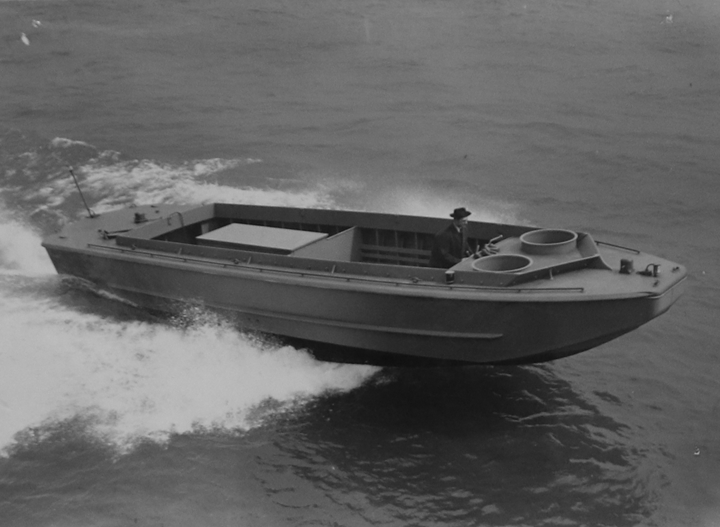
A Chris-Craft LCP(L) Eureka 36-foot boat under test.
It is being piloted by Hansen Smith, son of the founder of Chris-Craft,
Chris Smith.
This could very well be from the first contract that Chris-Craft won
away from Higgins. Photo courtesy of the Algonac-Clay
Township Historical Society added 3-15-2020.
World War Two Small Landing craft
designations:
Landing Craft, Personnel (LCP(L)) -
This was the first landing craft designed by Andrew Higgins in New
Orleans. It had no ramp and could only carry personnel. While
not as famous as the later LCVP, it was used for many purposes where a
ramped landing craft was not needed. It was used by both Army and Navy, where a good solid boat was needed to work in shallow water and
land on beaches as the need arose. It was still in
production late in the war. It could carry 36 troops; but to exit
the boat, they had to jump over the gunwales. While this feature of
the craft was not any better than previous landing boats, the LCP(L) did
have the ability to get right up onto the beach. Chris-Craft built
at least 1,038 LCP(L)s during World War Two.

Going over the sides or front has
been the way warriors have exited from landing craft since there have
been amphibious landings. Under fire, this is a hazardous operation.
In this case, the LCP(L) has not landed far enough onto the beach, which
is what it was supposedly designed to do. In the Navy competition,
the Chris-Craft contender was able land 20 feet farther onto the beach
than the Higgins design, yet the Navy chose the Higgins design instead.
The five feet drop from the bow to the beach could still cause
injury to the soldiers as they have to jump off the boat.

These two outline drawings are from the "Operators Manual,
36-foot "Eureka" Landing Motor Boats," revised June 1944, by Higgins
Industries. Chris-Craft and other manufacturers of the LCP(L)
built them from outline drawings like these, a full set of
details drawings, and parts lists. Drawing added 2-14-2020.

Drawing added 2-14-2020.

The final product looked like this, which is
a 1944 Higgins-built LCP(L). It is on display at the National
World War Two Museum in New Orleans, LA. Author's photo added
2-14-2020.
Landing Craft Personnel, Ramp (LCP(R)) - This
was an improved version of the LCP(L), which had a small ramp on the
front. The ramp allowed one or two persons at a time to exit the boat in the
front. It also added two gun tubs for mounting .30 caliber
machine guns. The coxswain's steering position was on the port
side, front as it was in the LCP(L).

This is an interesting photo of an LCP(R)
under construction at Chris-Craft. The coxswain's position is next
to the engine of this boat. In the production boats, as in the
photo below, it was farther forward in the landing craft. This may
be a prototype, as Chris-Craft did the original work and design of the LCP(R). Photo courtesy of the Algonac-Clay Township
Historical Society added 3-15-2020.

This is the correct configuration of the
LCP(R). Photo courtesy of the Algonac-Clay Township Historical
Society added 3-15-2020.

Photo courtesy of the Algonac-Clay Township Historical Society added
3-15-2020.

This photo shows that, in reality, only one
soldier or marine could exit the ramp on an LCP(R) at a time. A
test between the different types of landing craft showed that it
took 32 seconds for 36 troops to exit the boat. Photo courtesy of
the Algonac-Clay Township Historical Society added 3-15-2020.
In August 1942, tests were
performed by the Amphibious Command of the U.S. Corps of
Engineers to determine how long it took for 36 fully equipped troops
to exit the LCP(L), the LCP(R) and the LCVP.
|
Results of test for determining how quickly troops can depart a
landing craft |
|
Landing Craft |
Results (Seconds) |
Comments |
| LCP(L) |
57 |
Soldiers had to jump over the gunwales as shown in the photo
above. |
| LCP(R) |
32 |
Soldiers have to exit single file. |
| LCVP |
19 |
|

This Chris-Craft World War Two era magazine
advertisement shows that maybe two fully equipped soldiers can come
through the ramp at a time. Some are also jumping over the
gunwales to exit. Hopefully, the soldier doing that in the nearest
landing craft does not become a friendly fire casualty as he runs in
front of the firing .30 caliber machine gun. Obviously, this was
not the ultimate solution to effectively landing combat troops onto a
hostile beach. Chris-Craft built at least 2,432 LCP(R)s during World
War Two.

An LCP(R) loaded on a flatcar at Algonac,
MI. Photo courtesy of the Algonac-Clay Township Historical
Society added 3-15-2020.

During World War Two Navy UDT teams used the
LCP(L) for its drop-off and pick-up craft. The coxswain's port
side steering position was a definite advantage of the LCP(R), allowing
him to see where the swimmers were in the
water. The spotter is up in forward ramp section, so he can also see
where the swimmer was in the water and verify that he was picked up.
Landing Craft, Vehicle (LCV) - This was the next design of the
American landing craft, which now had a ramp across the entire bow for small vehicles like the
jeep that is in this one. It could also carry a jeep trailer or a
37mm anti-tank gun. However, the coxswain's position on top of the
stern leaves him in a precarious position exposed to enemy fire while
landing on a hostile beach. Also, there are no dedicated positions
for the .30 caliber machine guns for self-defense.


The LCV's designation may have not included
"Personnel," but it was also used for that purpose. Here, US Army
troops are landing on Guadalcanal in 1943 to relieve the US Marines who
fought long and hard to secure the island. This is a non-hostile
beach, so there is no issue for the coxswains in their exposed
positions. Chris-Craft constructed at least 600 of the 2,286 LCVs built.
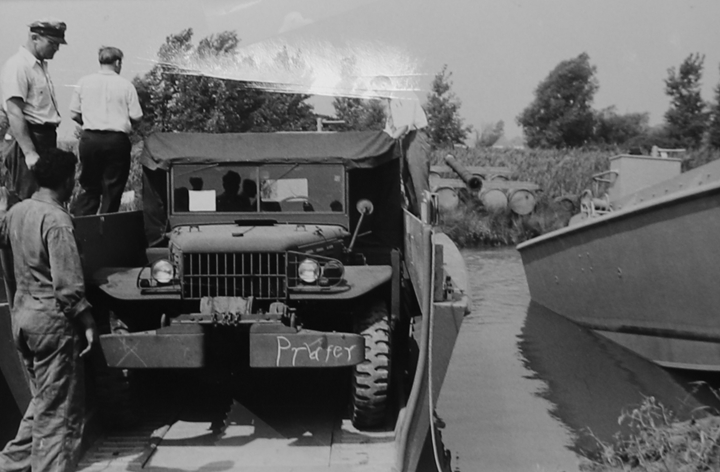
Shown here are two LCVs. The
coxswain's position can be seen on the LCV in the right hand side of the
photo. Chris-Craft employees have loaded a Dodge weapons carrier
into the LCV on the left. The throttle bar of the left boat can be
seen just above the canvas roof on the Dodge truck. Photo
courtesy of the Algonac-Clay Township Historical Society added 3-15-2020.
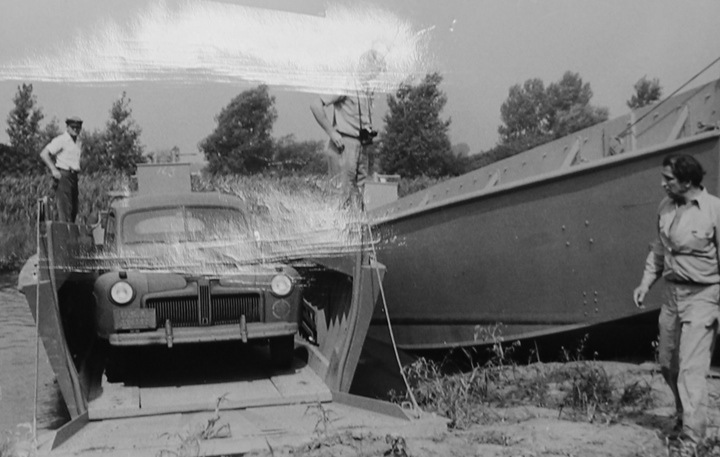
In this photo, a staff car has been
loaded into the LCV for testing. Here, the top of coxswain's station is
clearly visible behind the staff car. Photo
courtesy of the Algonac-Clay Township Historical Society added 3-15-2020.
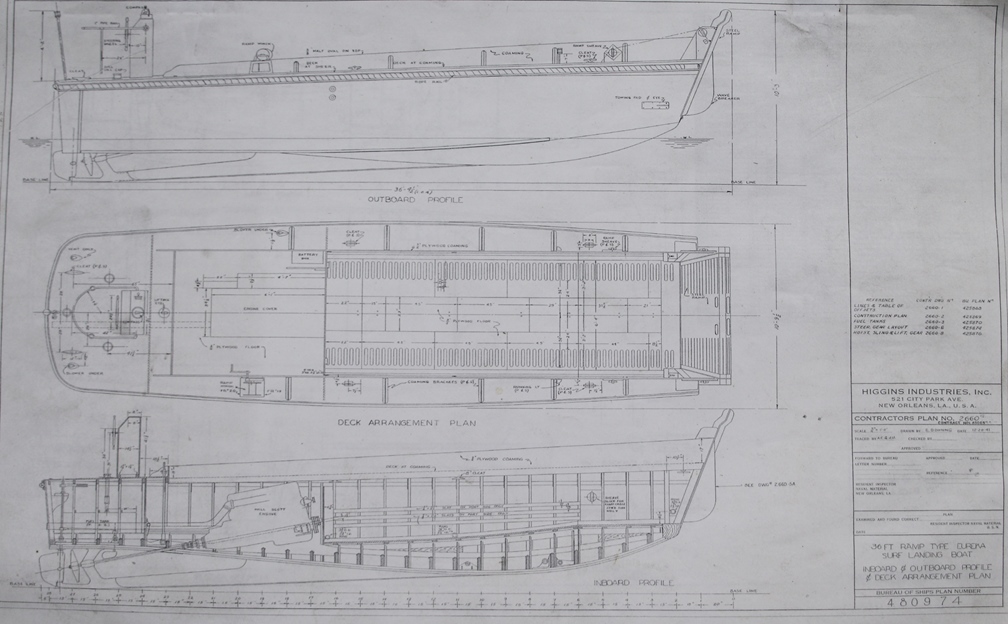
The name given to the LCV at the time of
this drawing on 12-29-1941 was 36 Foot Ramp Type Eureka Surf Landing
Boat. Chris-Craft would have used this outline drawing, the
one below, a full set of detail drawings, and a parts list to build
the LCV. Engineering drawing courtesy of C. Robert Gillmor added
2-14-2020.

The length of the boat was 36 feet and
4-1/2 inches. It was 10 feet and 9 inches in height, and 10
feet and 9-1/2 inches wide. The engine shown is a Hall-Scott
168 Invader six-cylinder gasoline powered engine. Hudson Motor
Car Company supplied many of the Invader engines for this landing craft.
Other engines were installed in this boat depending on availability. Engineering
drawing courtesy of C. Robert Gillmor added 2-14-2020.

C. Downing drew this engineering drawing
of the 36 Foot Ramp Type Eureka Surf Landing Boat on 12-29-1941.
Note that it was neither checked nor approved. Engineering
drawing courtesy of C. Robert Gillmor added 2-14-2020.
Landing Craft, Vehicle, Personnel (LCVP) (Higgins Boat) - This was
the final design and the definitive small wooden American landing craft
of World War Two. The coxswain's position was moved down onto the
deck besides the engine. Two positions for .30 caliber machine
guns were placed at the stern of the boat. It had the large ramp
of the LCV for quick egress on the beach for both troops and/or
vehicles. 23,397 were built by six companies during World War
Two. Chris-Craft built at least 8,865 LCVPs during World War Two.

This is Utah Beach at Normandy, France, June
6,1944. LCVP #22 from the Attack Transport APA-13, the
Joseph T. Dickman, is loaded with troops ready to head to the beach.
A boat like this comes to mind when one thinks of World War Two landing craft. There were 1,089 LCVPs at Normandy. Based
on Chris-Craft's percentage of the LCVPs built, about 400 of them at
Normandy would
have been Chris-Craft-built. Eighty-one of the 1,089 LCVPs were destroyed on D-Day,
mostly on Omaha Beach. Chris-Craft tribal legend contends the
first landing craft to land on the beaches of Normandy was a
Chris-Craft.

The Holland Plant's 8,000th
landing boat. This boat, along with all of the others built in
Holland and Cadillac, were trucked to the Algonac plant for testing in the St.
Clair River. Lake Michigan and Lake Cadillac can freeze over in the winter. The Algonac plant ran hot water lines into
the test basins in the St. Clair River to keep them ice free during
the winter.

This photo of Holland-built #8000 is in
the St. Clair River in Algonac during its in-water tests. All
the boats from Holland and Cadillac were tested at Algonac.
The Algonac location can be identified by the cranes in the
background.

Photo courtesy of the Algonac-Clay Township Historical Society
added 3-15-2020.
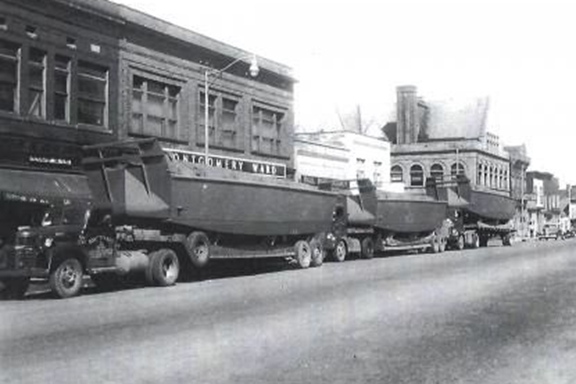
Chris-Craft built-LCVPs loaded on trucks in downtown
Cadillac, MI are on their way to Algonac for testing in the St. Clair
River.

An LCVP during testing along the St.
Clair River. For this particular boat, Chris-Craft used round
head screws to mount the armor plate. Photo courtesy of the
Algonac-Clay Township Historical Society added 3-15-2020.
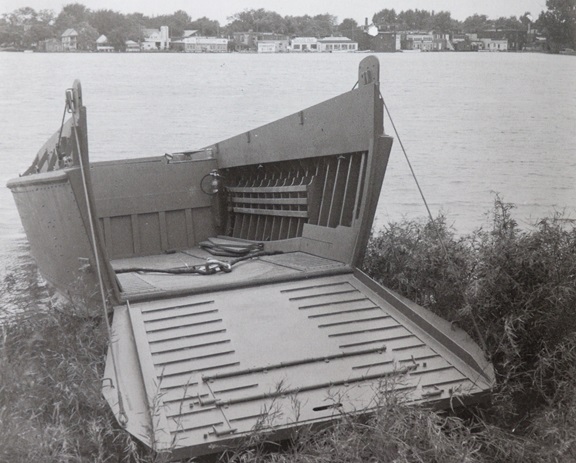
An LCVP during testing along the St.
Clair River.

This LCVP is being lowered into the
water at Algonac for testing. Photo courtesy of the
Algonac-Clay Township Historical Society added 3-15-2020.

The next two photos show dozens of LCVPs wrapped up against the elements as they await either testing
or shipment to the navy. If the waters of the test basin are
frozen, then these landing craft are waiting to be tested before
shipment. Photo courtesy of the Algonac-Clay Township
Historical Society added 3-15-2020.

Photo courtesy of the Algonac-Clay
Township Historical Society added 3-15-2020.

This Chris-Craft-built LCVP is coming
back to the factory area after its test run. Photo courtesy of
the Algonac-Clay Township Historical Society added 3-15-2020.

This ramp hoisting gear layout drawing gives a general idea of the
outline of the LCVP. Chris-Craft would have built its share of
the LCVPs from a full set of prints provided by Higgins Industries. Engineering drawing courtesy of C. Robert
Gillmor added 2-14-2020.
The Chris-Craft
Mystery Boat: The following photos were found in the
Algonac-Clay Township Historical Society's photo files. On the
back of each photo, it says "WWII landing barge." There is no
date on the photo. The appearance of the boat and its
length do not seem to match any of the water
craft known to have been built by Chris-Craft in World War Two. With the separate section behind
the coxswain's station, which can be covered with a canvas cover and
the padding around the craft, this appears to be some sort of VIP
transport.
In the listing of
documents at the Mariner's Museum in Newport News, VA, there is a
file for a 28-foot Personnel Boat, Mark 4 and 5. This may very
well be this craft. There were at least four of them built as
shown in the photos below. It is about the correct length.
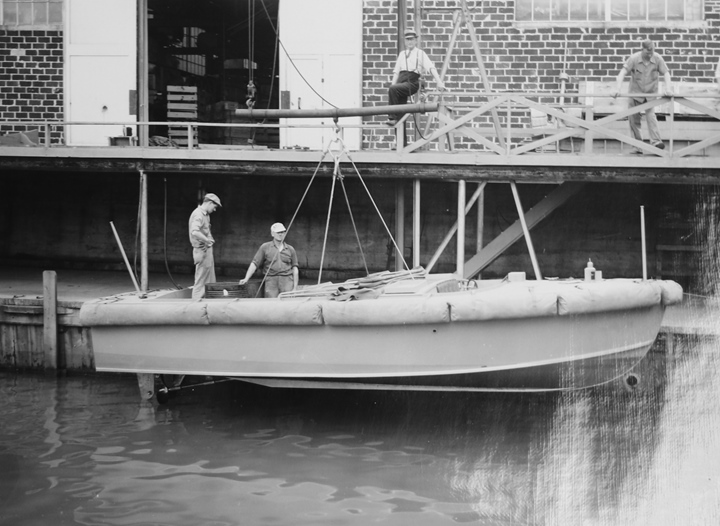
Photo courtesy of the Algonac-Clay
Township Historical Society added 3-15-2020.

Photo courtesy of the Algonac-Clay
Township Historical Society added 3-15-2020.

Photo courtesy of the Algonac-Clay
Township Historical Society added 3-15-2020.

Photo courtesy of the Algonac-Clay
Township Historical Society added 3-15-2020.

There are four of the mystery boats in
this photo. Photo courtesy of the Algonac-Clay Township
Historical Society added 3-15-2020.

Photo courtesy of the Algonac-Clay
Township Historical Society added 3-15-2020.

Photo courtesy of the Algonac-Clay
Township Historical Society added 3-15-2020.

Photo courtesy of the Algonac-Clay
Township Historical Society added 3-15-2020.
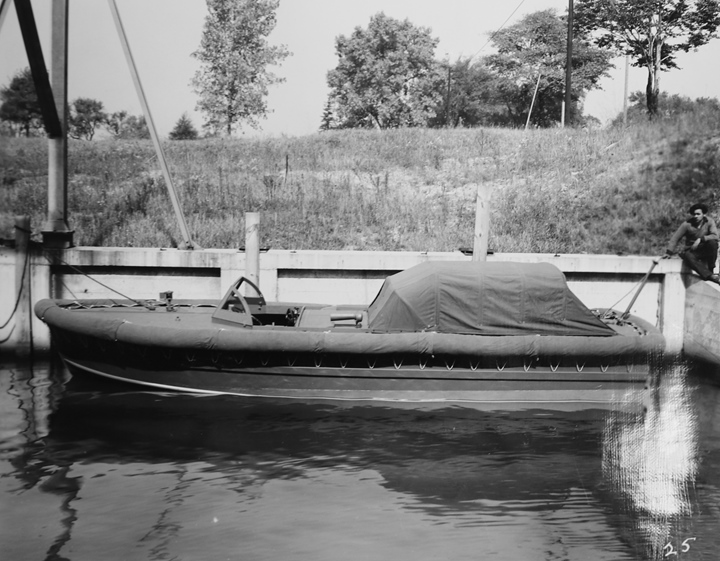
Photo courtesy of the Algonac-Clay
Township Historical Society added 3-15-2020.

Chris-Craft-built AC-1 under way. The
use of water cooled .50 caliber machine guns on this army boat seems
unusual, as normally they are air-cooled.
Photo courtesy of the Algonac-Clay Township Historical Society added
3-15-2020.

This 60-foot Algonac built boat was
manufactured for the U.S. Army in 1941 as Quartermaster Corps. It
was designated Q-37.

Twenty-nine
22-foot utility boats were also ordered by Army Air Force for Air-Sea
Rescue of air crews. Each was powered by a Chris-Craft 95 hp Model K
engine that could power the boat to 31 mph.

The 42-foot rescue boat was based on
an Owens Yacht Company recreational boat design. Chris-Craft built
49 of them in 1942 and 1943. Image added 2-14-2020.

Image added 2-14-2020.

Image added 2-14-2020.

The top boat in the ad is a U.S. Army Q boat,
the middle is a U.S. Navy picket boat, and the bottom is a U.S. Navy LCP(L) landing
craft.

Note that the Navy "E" flag, which
Christ-Craft originally won, is shown
in the upper left hand corner of this ad. Later the flag was converted to the Army-Navy "E" flag.
The Chris-Craft Plants of World War Two:
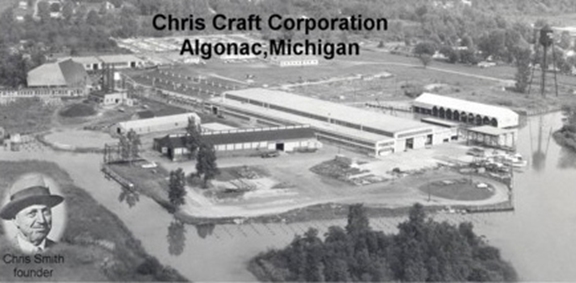
Chris-Craft was the major employer in
Algonac, MI. The 264,000 square foot plant was on the St. Clair
River. New designs were tested on the river.
During World War Two, Algonac built the larger boats, which all had to be
tested on the river before being accepted by the US military. The
plant opened in 1922 and closed in 1970. Its closure brought the
end of an era to Algonac and devastated its economy.

The Algonac plant in 1958. Photo
courtesy of the Algonac-Clay Township Historical Society added 3-15-2020.

This is the building at the top of the
Algonac plant layout above. Today it is an upholstery shop.
Author's photo added 3-15-2020.

The original Chris-Craft water tower in
Algonac still stands. Author's photo added 3-15-2020.

This vacant plant was purchased in January 1941 from the city of
Cadillac, MI, and was repurposed to build 18-22 foot utility boats.
During World War Two it produced 2,000 landing craft. It was
125,000 square feet and operated between 1941 and 1968.

The Chris-Craft Holland plant was a
purpose-built plant to build 15.5 foot to 42 foot boats. It had 600x110 feet
under roof on 22 acres. It was built at a
cost of $300,000. It made its first shipment in January 1940. Over
10,000 36-foot landing craft were produced here.
|
 a
a




































































